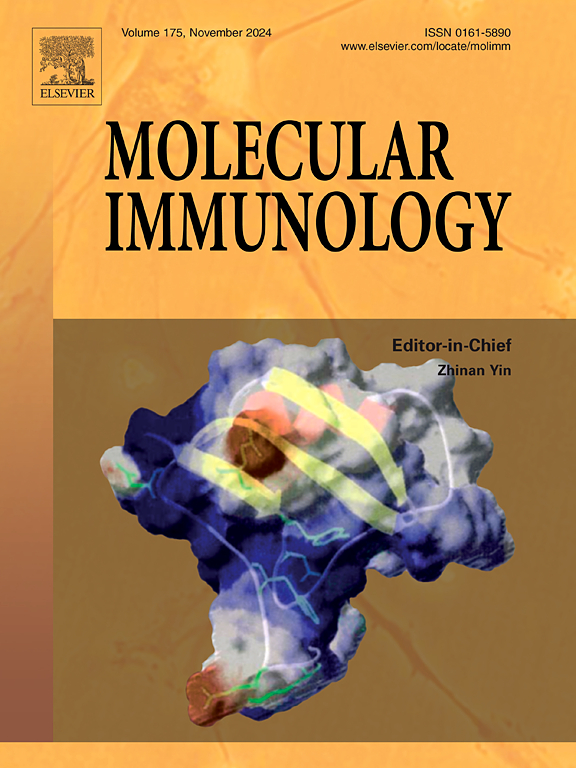新型单磷酰脂质a的佐剂活性及作用机制研究
IF 3
3区 医学
Q2 BIOCHEMISTRY & MOLECULAR BIOLOGY
引用次数: 0
摘要
为了开发一种高效、经济、适合广泛应用的新型疫苗佐剂,本研究采用合成生物学技术制备了新型大肠杆菌单磷酸脂质a (N-MPL)。具体地说,去掉了C-1位置的磷酸基团,在原脂质a结构的3′-仲脂肪酸链上引入了一个羟基。这种改性旨在降低毒性,同时提高水溶性。制备了两种N-MPL配方,并对其免疫活性和佐剂活性进行了评价。结果表明,两种制剂均能促进免疫细胞的增殖和骨髓源性树突状细胞的成熟。在一项用H1N1疫苗对ICR小鼠进行的佐剂免疫实验中,与铝佐剂和市售的单磷酰脂质A(合成)(PHAD™)相比,N-MPL表现出更好的佐剂效果。通过对免疫小鼠脾淋巴细胞、抗体、细胞因子和免疫因子的综合分析,首次发现不同配方的N-MPL佐剂可以调节细胞免疫和体液免疫,但诱导免疫反应的焦点不同。水包油型N-MPL主要诱导小鼠细胞免疫应答,而水溶液型N-MPL主要诱导体液免疫应答。机制研究表明,N-MPL通过TLR4-MyD88-NF-κB信号通路调节Th1/Th2反应。综上所述,新型N-MPL佐剂效率高、成本低,在疫苗佐剂开发方面具有重要潜力。本文章由计算机程序翻译,如有差异,请以英文原文为准。
Study on the adjuvant activity and mechanism of action of a novel Monophosphoryl Lipid A
In order to develop a novel vaccine adjuvant that is highly efficient, cost-effective, and suitable for widespread application, this study employed synthetic biology techniques to produce a new type of Escherichia coli monophosphate lipid A (N-MPL). Specifically, the phosphate group attached to the C-1 position was removed, and a hydroxyl group was introduced into the 3′-secondary fatty acid chain of the original lipid A structure. This modification aimed to reduce toxicity while enhancing water solubility. Two formulations of N-MPL were prepared and their immunological and adjuvant activities were evaluated. Results demonstrated that both formulations could promote the proliferation of immune cells and the maturation of bone marrow-derived dendritic cells (BMDCs). In an adjuvant immunization experiment using H1N1 vaccine in ICR mice, N-MPL exhibited superior adjuvant effects compared to aluminum adjuvants and commercially available Monophosphoryl Lipid A (Synthetic) (PHAD™). Through comprehensive analysis of splenic lymphocytes, antibodies, cytokines, and immune factors in immunized mice, it was discovered for the first time that different formulations of N-MPL adjuvants could regulate cellular and humoral immunity, albeit with distinct foci of induced immune responses. The oil-in-water formulation of N-MPL primarily induced cellular immune responses in mice, whereas the aqueous solution formulation predominantly elicited humoral immune responses. Mechanistic studies revealed that N-MPL regulates the Th1/Th2 response via the TLR4-MyD88-NF-κB signaling pathway. Overall, the novel N-MPL adjuvant exhibits high efficiency and low cost, demonstrating significant potential for vaccine adjuvant development.
求助全文
通过发布文献求助,成功后即可免费获取论文全文。
去求助
来源期刊

Molecular immunology
医学-免疫学
CiteScore
6.90
自引率
2.80%
发文量
324
审稿时长
50 days
期刊介绍:
Molecular Immunology publishes original articles, reviews and commentaries on all areas of immunology, with a particular focus on description of cellular, biochemical or genetic mechanisms underlying immunological phenomena. Studies on all model organisms, from invertebrates to humans, are suitable. Examples include, but are not restricted to:
Infection, autoimmunity, transplantation, immunodeficiencies, inflammation and tumor immunology
Mechanisms of induction, regulation and termination of innate and adaptive immunity
Intercellular communication, cooperation and regulation
Intracellular mechanisms of immunity (endocytosis, protein trafficking, pathogen recognition, antigen presentation, etc)
Mechanisms of action of the cells and molecules of the immune system
Structural analysis
Development of the immune system
Comparative immunology and evolution of the immune system
"Omics" studies and bioinformatics
Vaccines, biotechnology and therapeutic manipulation of the immune system (therapeutic antibodies, cytokines, cellular therapies, etc)
Technical developments.
 求助内容:
求助内容: 应助结果提醒方式:
应助结果提醒方式:


